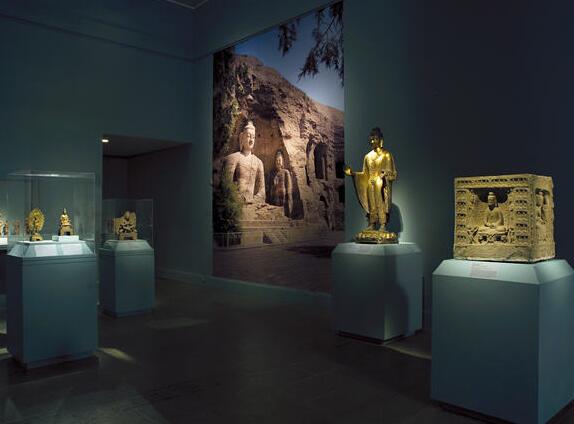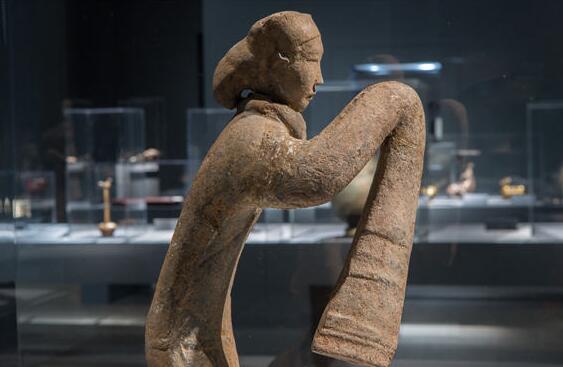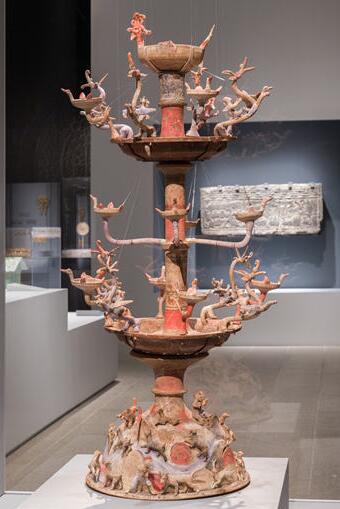Precious best placed into the safest hands
From:China Daily NetWriter:Zhao XuDate:2018-02-06
Those who put China's historic treasures on display have a delicate task as they prepare them to be exhibited.Qian Wei of Art Exhibitions China, who was closely involved in the blockbuster show Age of Empires at the Metropolitan Museum of Art in New York last year, says that throughout the show she was more impressed by the installation and withdrawal of the exhibits than by anything else.

Met exhibition Dawn of a Golden Age. 200-750 AD (2004-05). [Photo provided to China Daily]
"For me, those are the parts where the professionalism of the Met staff crystallized," she says, referring to the show that put on view nearly 300 pieces of unearthed treasures from the Qin and Han dynasties (221 BC-220 AD). It drew more than 355,000 visitors between April and July.
"Unlike the many other museums we have worked with, the Met doesn't require the service of a transport company after the exhibits land in the US. Instead they rely on their own team whose members can only be called specialists.
Qian has been with Art Exhibitions China for 27 years, a job with the official Chinese organization that entails helping organize star shows overseas that highlight the country's lustrous cultural heritage.
"I still have the image of a Met worker in my mind," she says.

Age of Empires: Han Dynasty pottery dancer on display at the Met exhibition. [Photo provided to China Daily]
"He came close to one of the exhibits, a bronze pot from more than two millennia ago in this case. Instead of getting down to work as I had expected, he bent down and walked around it, examined every crack carefully. That's when he started asking us questions about the pot's condition, its weak points, whether it had been repaired ...basically everything he needed to know before putting his hands on this precious piece of history.
"Their movements were always tentative, and filled with a thoughtfulness that could only be informed by a heartfelt reverence for history."
Jason Sun (Sun Zhixin), curator of the Met's Asia Art Department who is behind the exhibition, says "the Met's excellent reputation for caring for and conserving works of art has always made it possible to request loans that require special treatment".
"A pottery lamp with three tiers and multiple branches, for example, was one of the most fragile among the loans in the exhibition. The Met installation team spent several days creating a stand with a central pole and three separate trays to provide full support to keep the object safe throughout the display."
Sun, who graduated from Princeton University with a doctoral degree in Chinese art history and archaeology, and who hails from Beijing, saw his entire career coinciding, or being propelled by, the steadily increasing cultural exchanges between China and his adopted home. In fact, his resume over the past 15 years covers all of the three major exhibitions that were the result of close collaboration between the Met and Art Exhibitions China. They were China: Dawn of a Golden Age, 200-750 A.D. (2004-05), The World of Khubilai Khan: Chinese Art in the Yuan Dynasty (2010-11) and the latest, the Age of Empires: Chinese Art of the Qin and Han Dynasties.
"There's always a six-year interval between consecutive exhibitions," Qian says. How come it has taken so long? Well, you wouldn't be surprised if you were familiar with the effort needed to put together a milestone show like one of the three," Qian says.
According to her, the nearly 300 exhibits came from 32 museums and cultural institutions in 13 Chinese provinces.
"It was a mammoth task to convince every one of them to part for six months with what in many cases are their most-treasured exhibits in their collections," says Qian, who, with Sun, visited many of the contributing museums in 2014 and 2015.

Age of Empires: The pottery lamp with three tiers and multiple branches. [Photo provided to China Daily]
In fact, Qian believes that one of the biggest factors behind the successful mounting of the exhibition is the strong support at government level.
"Art Exhibitions China is directly under the State Administration of Cultural Heritage, a governmental organization that has the final say over all matters concerning any antique, including its departure from the country.
"The fact that the Chinese Cultural Minister Luo Shugang attended the opening ceremony of the Met show in itself says a lot. It may also be worth mentioning that Henry Kissinger, national security adviser and secretary of state under president Richard Nixon, and who played a vital role in normalizing relations between China and the US, is a trustee emeritus of the Metropolitan Museum."
Sun joined Qian in emphasizing state-level collaboration.
"The US-China Consultation on People to People Exchanges, co-sponsored by the US State Department and China's State Council, lent tremendous support to the exhibition," he says.

The World of Khubilai Khan: Chinese Art in the Yuan Dynasty (2010-11). [Photo provided to China Daily]
"Without Art Exhibitions China's indispensable assistance with communication, coordination and assembling the art works, none of the exhibitions would have been possible," says the curator who joined the Met in 1999, and who is adamant about his own role.
"The underlying exhibition concept and the selection of artworks to realize that conception belong to the curator and the curatorial team," he says.
Qian, for her part, believes that the Art Exhibitions China team also put its stamp on the final show. "For one reason or another, nearly one third of the exhibits appearing in the initial list the Met gave us had to be changed. Some objects were too fragile or too precious to leave the country, and others were being studied by historians and conservationists and were thus unavailable.
"One example involves two groups of bronze chime bells known as bianzhong. The Met had initially wanted a set that had been on permanent display in a museum in East China but was refused. So we suggested another set unearthed in a major archaeological discovery in southwestern China in 2015. It was accepted. One way we made our contribution was by making suggestions for replacements based on our knowledge about what we had and our understanding of the show's motif. Sometimes what we finally came up with proved a better choice than what was originally asked for."
Since 1980, the year of the Met's first major exhibition with Chinese institutions, the Great Bronze Age of China, the museum has not only mounted 18 exhibitions with works from China but has also taken part in eight exhibitions in China by lending to Chinese museums, Sun says.
"This is undoubtedly a result of China's rapid development as well as the increasing willingness of both sides to work together."

The Age of Empires exhibition at New York's Metropolitan Museum of Art drew more than 355,000 visitors between April and July last year. [Photo provided to China Daily]
Sun says he believes the Met show is about China and more.
"It helps audiences to compare and understand by placing China's history of civilization in the larger context of the world's history of civilization. The contact between China and the rest of the world, especially the connections and interactions between the Qin and Han dynasties and the Greco-Roman world, helps bring the exhibition close to the audience. China of the Qin and Han times is no longer a remote and unknown land but an integral part of the entire world, and has inextricable ties with the West in many ways."
Echoing Sun, Qian also mentions the "pottery lamp with three tiers and multiple branches".
"A whole team of about 20 people spent an entire morning dismantling and packing this one item after the exhibition ended. If I remember rightly, three of them were responsible for opening the glass cabinet where the lamp had been showing, followed by a few others who did the dismantling. Every single part taken down was quickly handed to another person who put it on a tray that could be wheeled around on the specially designed cart.
"The whole process reminded me of a scene in an operating theater, with the scalpel being passed between doctor and nurse, who have developed a tremendous deal of tacit understanding with one another other.
"In a sense, they were all narrators of a Chinese story."

